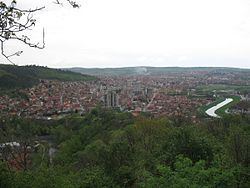Settlements 107 Time zone CET (UTC+1) Local time Tuesday 4:55 AM | Elevation 273 m (896 ft) Area 759 km² | |
 | ||
Weather 2°C, Wind W at 6 km/h, 76% Humidity | ||
Yugoslavia prokuplje anti milosevic protests 2
Prokuplje (Serbian Cyrillic: Прокупље, [prǒkupʎe]) is a town, municipality and the administrative center of the Toplica District in the southern Serbia. According to 2011 census, the town has a total population of 27,333 inhabitants, while population of municipality is 44,419. It is one of the Roman sites of Serbia. It was a kaza center in Niš sanjak as "Ürgüp" during Ottoman rule and was incorporated in Kingdom of Serbia in 1878.
Contents
- Yugoslavia prokuplje anti milosevic protests 2
- Map of Prokuplje Serbia
- Geography
- History
- Archaeological findings
- Economy
- Demographics
- Twin towns Sister cities
- References
Map of Prokuplje, Serbia
Geography
The Prokuplje municipality is located between municipalities of Blace, Kuršumlija, Bojnik, Žitorađa, Merošina, Aleksinac, and Kruševac.
History
The traces of early settlements can be found on neolithic localities such as Macina (near Zitni Potok), Kavolak 6 kilometres (4 miles) west of Prokuplje (village Donja Trnava) and settlements on the south slopes of Jastrebac in Donja Bresnica village. The Vinca period is preserved in the Plocnik locality (22 km [14 mi] from Prokuplje), on the left side of the road from Prokuplje to Kursumlija. The earliest known metalworking in the world was found in Pločnik in 2007 dating to 5500 BC making the Copper Age several centuries older than previously thought. Those agricultural settlements were replaced by the emerging Thracians and then the invading Celtic Scordisci in 279 BC. Pieces of ceramics found by the Latin church are traces of those tribes movement on their way to Greece.
Between 73-75 B.C., after the Romans subjugated the tribes of the region, this part of Serbia became a part of the Roman province of Moesia. It was part of the Roman „via militaris“ (connecting the central Balkans with the Adriatic) from Niš, the town was known as Hammeum, or Hameo; the first known name of the settlement. At the end of 4th century A.D., when the Roman empire was divided, all settlements in Toplica region belonged to (Byzantine Empire). The name of the place was Komplos or Komblos (village-town). Some historians believed that Komplos was rebuilt by Emperor Justinian.
When South Slavic tribes first settled in this area in the 6th century, Komplos was rendered as the Slavic Prokuplje.
The first written document about today’s town name is from 1395 A.D. when the Duchess Milica gave away as a present two houses and some belongings from the town of St. Prokopius to St. Panteleimon monastery on holy Mount Athos in modern-day Greece. Today’s name of the town of Prokuplje was first seen in use after the replacement of St. Prokopius' relics from Nis in the year 1396 A.D.
In early middle age, during the rule of Stefan Nemanja, Prokuplje is not mentioned in any written documents. The settlement gained its importance during Tsar Lazar's reign period, before the Ottoman invasion, when the fortress on Hisar Hill was rebuilt. Prokuplje was besieged in 1454 and during 423 years of Turkish rule the name of the place was Urcub or Okrub. It was part of the Sanjak of Niš. Between the 16th and 17th centuries, the town's importance increased (similarly to other towns, such as Kruševac, Stalac and Leskovac). Prokuplje prospered through the trade connections with Dubrovnik. During the Great Turkish War Prokuplje was captured by Austrian troops and Serbian Militia in 1689 and burned down during their retreat in 1690, although colonel Antonije Znorić ordered otherwise.
Prokuplje was liberated from the Ottomans in the 19th of December, 1877, and the whole Toplica region was liberated in 1877. Toponyms such as Arbanaška and Đjake shows an Albanian presence in the Toplica and Southern Morava regions (located north-east of contemporary Kosovo) before the expulsion of Albanians during 1877–1878 period. The rural parts of Toplica valley and adjoining semi-mountainous interior was inhabited by compact Muslim Albanian population while Serbs in those areas lived near the river mouths and mountain slopes and both peoples inhabited other regions of the South Morava river basin. As the wider Toplica region, Prokuplje also had an Albanian majority. These Albanians were expelled by Serbian forces in a way that today would be characterized as ethnic cleansing. From 1929 to 1941, Prokuplje was part of the Morava Banovina of the Kingdom of Yugoslavia. During the First and Second World War Prokuplje was completely destroyed, but in the post-war period it became an industrial town.
Archaeological findings
In July 2008 a major Roman spa was unearthed.
On October 9, 2008, Serbian archaeologists at Pločnik found a copper axe believed to be 500–800 years older than the actual beginning of the Copper Age, suggesting that the human use of metal is older than believed.
Economy
Prokuplje has a weak economy, with most of the employed people working in public sector. In 2009, LEONI Wiring Systems Southeast opened a factory in Prokuplje, employing over 1900 people.
Demographics
According to the last official census done in 2011, the Municipality of Prokuplje has 44,419 inhabitants. Most of Prokuplje’s population is of Serbian ethnicity (92.16%) while 61.5% of the municipality’s population is urban.
Ethnic composition of the municipality:
Twin towns – Sister cities
Prokuplje is twinned with:
